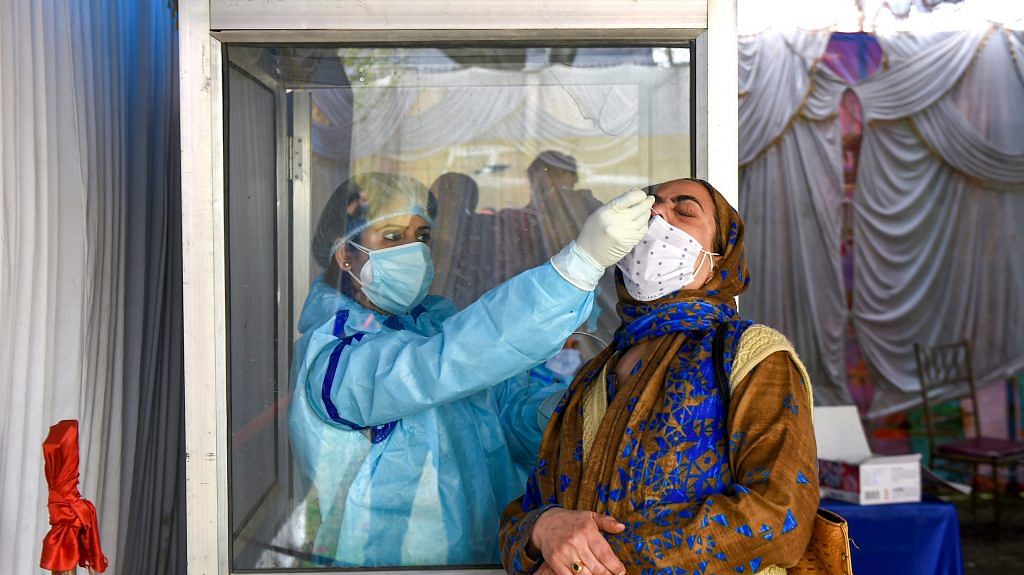New Delhi: There has been a marginal increase in the number of 0-19-year-olds affected in the ongoing second wave of the Covid-19 pandemic, as compared to the first wave, analysis of data for hospitalised patients has shown.
Around 5.8 per cent of the patients hospitalised during the second wave of Covid-19 are from this age group, compared to 4.2 per cent in the first wave, from September to November 2020, according to the analysis.
The analysis was shared by the Government of India during the Covid briefing Monday. Among other things, the study — conducted among 9,485 hospitalised patients — offered insights on the age profile of hospitalised Covid patients, and the incidence of different symptoms like shortness of breath and sore throat.
The analysis shows an uptick — only slight — in hospitalised Covid-19 patients in the 20-39-year age group — 25.5 per cent in the second wave, compared to 23.7 per cent in the first wave. A total of 72.2 per cent of the hospitalised patients in the first wave were above 40 years old. That number has come down to 69.8 per cent in the second wave.
According to the data, more patients have reported shortness of breath during the second wave — 47.5 per cent, against 41.7 per cent in the first wave. This data would partially explain why the requirement of oxygen has gone up in the second wave. The demand has also increased because of the surge in cases — daily numbers are now close to double the first-wave peak of less than 98,000 cases.
A total of 41.1 per cent of patients during the first wave required oxygen, with the number rising to 54.5 per cent in the second, the study found. In the first wave, 37.3 per cent of the patients required mechanical ventilation, compared to 27.8 per cent in the second wave.
Also Read: ‘Where are ambulances, Covid hospitals?’: Family of UP journalist who died without treatment
Difference in incidence of symptoms
Among the other major differences, the incidence of dry cough was found to have reduced to 34.9 per cent from 43.4 per cent, and that of sore throat to 7.5 per cent from 16 per cent.
As many as 54.9 per cent of the patients in the first wave had at least one comorbidity. That number is down to 48.6 per cent in the second wave. In the first wave, 64.5 per cent of the patients were males, a number that has come down marginally to 63.8 per cent.
The fact that vaccinations have been limited so far largely to over 45-year-olds, unless they belong to certain designated professions such as medicine, may have played some role in the age profile of patients.
The analysis also shows that a higher proportion of admitted patients are asymptomatic during the second wave than in the first one. It suggests there is no difference in the percentage of deaths across India, and the trends are similar across states.
Indian Council of Medical Research (ICMR) Director-General Dr Balram Bhargava, who presented the data, said oxygen supply for patient care needs to be ramped up even though ventilator requirement has not been higher in the second wave.
‘Remdesivir no magic bullet’
During the briefing, AIIMS Director Dr Randeep Guleria and NITI Aayog member Dr V.K. Paul repeatedly talked about the need to use medicine in a Covid patient at the right time and at the right dosage. Naming different medicines that have been touted as potential treatments for Covid-19, Guleria said none is a magic bullet.
“It is important to understand that remdesivir is not a magic bullet. It is of no use if given too early or in mild and asymptomatic individuals. You would end up with a cytokine storm in that case, rather than helping patients…” said Guleria.
“Steroids are also needed by very few patients, as is Tocilizumab. It is important to understand that the majority of patients get better just with symptomatic treatment, paracetamol, good hydration, multivitamins etc are good enough. No study shows that remdesivir can reduce mortality, it only reduces hospital stay a bit,” he added. Favipiravir, he said, is not a proven treatment either and has only got emergency-use authorisation.
Paul acknowledged there is a clamour for medicines, particularly remdesivir, and said efforts are being made to address the situation.
“We have stopped exports, we are increasing production, it will go up to 76 lakh vials (of remdesivir) soon,” he added.
They also stressed the importance of rationalised use of oxygen.
Asked whether the government believes that the virus is largely airborne, Paul said no matter the mode of transmission — by air or aerosol or droplets — the essential safety measures remain masking and social distancing.
(Edited by Sunanda Ranjan)
Also Read: There’s a need to hold up a mirror to Modi govt on Covid management, and this is the picture
